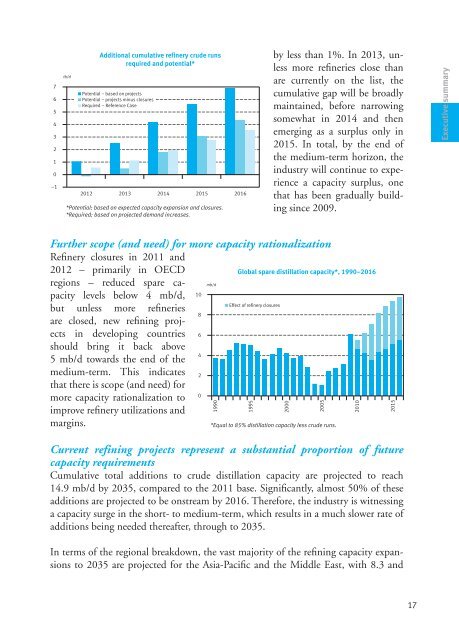World Oil Outlook - Opec
World Oil Outlook - Opec
World Oil Outlook - Opec
- TAGS
- world
- outlook
- opec
- www.opec.org
You also want an ePaper? Increase the reach of your titles
YUMPU automatically turns print PDFs into web optimized ePapers that Google loves.
7<br />
6<br />
5<br />
4<br />
3<br />
2<br />
1<br />
0<br />
–1<br />
tb/d<br />
0<br />
US &<br />
Additional cumulative refinery crude runs<br />
Canada<br />
required and potential*<br />
Potential – based on projects<br />
Potential – projects minus closures<br />
Required – Reference Case<br />
2012 2013 2014 2015 2016<br />
*Potential: based on expected capacity expansion and 0.5 closures.<br />
*Required: based on projected demand increases.<br />
Further scope (and need) for more capacity rationalization<br />
Refinery Distillation closures capacity in 2011 additions and from existing projects<br />
2012 – primarily in 2012–2016 OECD<br />
regions mb/d – reduced spare ca-<br />
mb/d<br />
2.5 pacity levels below 4 mb/d, 10<br />
but unless more refineries<br />
2.0<br />
are closed, new refining proj-<br />
8<br />
Effect of refinery closures<br />
ects in developing countries<br />
1.5<br />
should bring it back above<br />
6<br />
Figure 6.1<br />
5 1.0mb/d<br />
towards the end of the<br />
4<br />
medium-term. This indicates<br />
0.5 that there is scope (and need) for<br />
2<br />
more capacity rationalization to 0<br />
0<br />
improve US & refinery Latin utilizations Africa Europe and FSU Middle China Other<br />
Canada<br />
margins.<br />
America<br />
East<br />
Asia<br />
China Other<br />
by less than 1%. In 2013, un-<br />
East<br />
Asia<br />
less more refineries close than<br />
are currently on the list, the<br />
cumulative gap will be broadly<br />
2008–2014<br />
maintained, before narrowing<br />
somewhat in 2014 and then<br />
emerging Figure as 6.3 a surplus only in<br />
2015. In total, by the end of<br />
the medium-term horizon, the<br />
industry will continue to experience<br />
a capacity surplus, one<br />
that has been gradually building<br />
since 2009.<br />
Current Estimated refining distillation projects capacity closures represent as of mid-2012 a substantial proportion of future<br />
capacity requirements 2008–2014<br />
mb/d Cumulative total additions to crude distillation capacity are projected to reach<br />
2.0<br />
14.9 mb/d by 2035, compared to the 2011 base. Significantly, almost 50% of these<br />
additions are projected to be onstream by 2016. Therefore, the industry is witnessing<br />
1.5 a capacity surge in the short- to medium-term, which results in a much slower rate of<br />
additions being needed thereafter, through to 2035.<br />
1.0<br />
In terms of the regional breakdown, the vast majority of the refining capacity expansions<br />
0.5 to 2035 are projected for the Asia-Pacific and the Middle East, with 8.3 and<br />
0<br />
Europe US & Canada Asia Latin America<br />
1.0<br />
0.5<br />
2.0<br />
1.5<br />
1.0<br />
1990<br />
Global spare distillation capacity*, 1990–2016<br />
0<br />
mb/d<br />
Latin<br />
America<br />
Estimated distillation capacity closures as of mid-2012<br />
Global spare distillation capacity*, 1990–2016<br />
1995<br />
Africa Europe FSU Middle<br />
Europe US & Canada Asia Latin America<br />
2000<br />
2005<br />
*Equal to 85% distillation capacity less crude runs.<br />
2010<br />
2015<br />
17<br />
Executive summary<br />
Figu
















